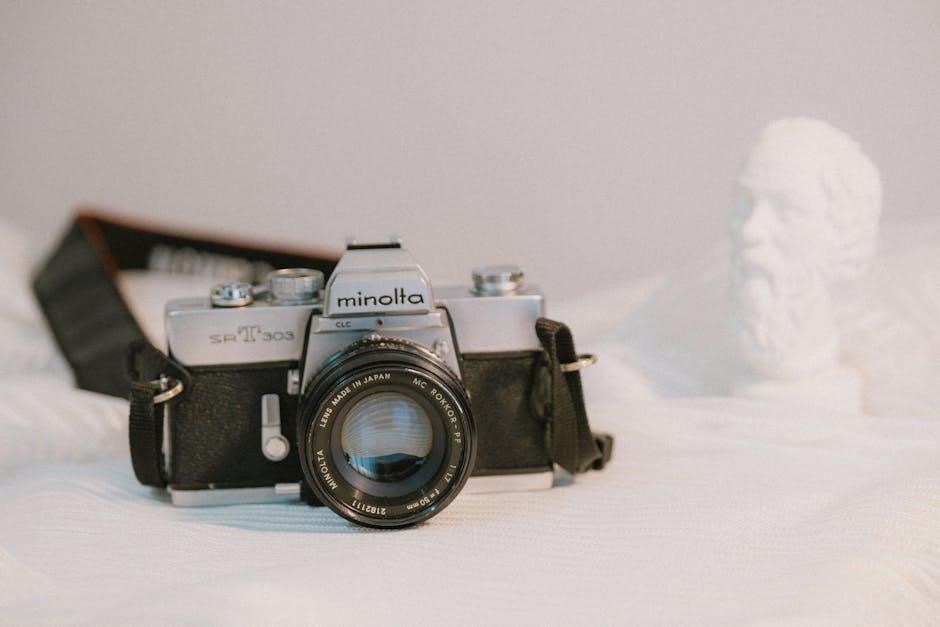The Minolta SRT 101 is a 35mm SLR camera known for its durability and reliability. Popular among photography students and professionals, it offers manual controls and a built-in CLC metering system for precise exposures. Its interchangeable lenses and intuitive design make it a versatile tool for various photography genres, from portraits to landscapes.
1.1 Overview of the Minolta SRT 101
The Minolta SRT 101 is a 35mm single-lens reflex camera renowned for its durability and reliability. Designed for both professionals and enthusiasts, it features a through-the-lens (TTL) metering system with Minolta’s exclusive CLC circuit for accurate exposures. The camera supports interchangeable lenses and offers manual controls, making it versatile for various photography needs. Comprehensive user manuals and service guides are available, ensuring easy operation and maintenance for users of all skill levels.
1.2 Key Features and Specifications
The Minolta SRT 101 offers a through-the-lens (TTL) metering system with an exclusive CLC circuit for accurate exposures. It features interchangeable lenses, manual controls, and a robust design. Comprehensive service manuals, including a 44-page PDF guide, are available for maintenance and repair. The camera supports various accessories and is known for its durability, making it a favorite among photography enthusiasts and professionals. Its advanced features and versatility ensure high-quality results across different photography genres.
Understanding the Camera Components
The Minolta SRT 101 features external controls such as the shutter speed dial and film advance lever. Internal components include the lens mount and TTL metering system.
2.1 External Controls and Functions
The Minolta SRT 101 features a shutter speed dial with speeds from 1/1000 to 1 second and a film advance lever for easy loading. The ASA setting, stop-down lever, and meter switch are also externally accessible. These controls provide precise adjustments for exposure and film handling. The ergonomic design ensures intuitive operation, making it easy to navigate for photographers of all skill levels.
2.2 Lens Compatibility and Interchangeability
The Minolta SRT 101 is compatible with a wide range of MC Rokkor lenses, offering versatility for various photography needs. Its interchangeable lens system allows photographers to switch between wide-angle, telephoto, and macro lenses effortlessly. This feature enhances creativity and adaptability, making the SRT 101 suitable for diverse genres. The robust lens mount ensures secure attachment, providing consistent performance across different lenses.

Loading and Advancing Film
Open the camera back, align the film with the spool, advance the film, and close the back. Use the frame counter to track exposures accurately.
3.1 Film Loading Process
Open the camera back by pulling the film release knob. Align the film with the spool, ensuring the perforations match. Gently advance the film using the rewind knob until it stops. Close the back, then advance the film to the first frame using the rapid advance lever. Check the frame counter to confirm the film is loaded correctly. This ensures proper tension and accurate frame counting for sharp images.
3.2 Film Advance and Frame Counting
After loading, advance the film to the first frame using the rapid advance lever. The frame counter will start at 1. Each depression of the shutter button advances the film to the next frame. The counter increments automatically, ensuring accurate tracking of exposures. Stop at frame 38 to avoid over-advancing. The counter resets automatically when the film is unloaded, providing a reliable way to monitor your shots throughout the roll.

Exposure Control and Metering
The Minolta SRT 101 features a through-the-lens metering system with a CLC circuit for accurate exposure readings, ensuring optimal results in various lighting conditions and contrast levels.
4.1 Through-the-Lens Metering System
The Minolta SRT 101 features a through-the-lens (TTL) metering system, which measures light directly through the lens for accurate exposure readings. This system uses a built-in CLC (Contrast Light Control) circuit to optimize metering in high-contrast situations, ensuring balanced exposures. The TTL system provides precise control over lighting conditions, reducing errors and enhancing image quality. It is a key feature that sets the SRT 101 apart from other cameras of its era.
4.2 Using the CLC (Contrast Light Control) Circuit
The CLC circuit in the Minolta SRT 101 enhances the TTL metering system by analyzing the entire picture area, providing accurate readings in high-contrast lighting. This feature ensures balanced exposures, capturing details in both bright highlights and dark shadows. The CLC circuit automatically adjusts to varying lighting conditions, making it particularly effective for challenging scenes. Its innovative design simplifies achieving professional-level results without manual adjustments, making it a standout feature for photographers of all skill levels.
Operating Modes and Shutter Speeds
The Minolta SRT 101 offers manual and automatic modes, providing flexibility for photographers. Shutter speeds range from 1/1000 to 1 second, plus B and T settings, ensuring precise control over exposures in various lighting conditions.
5.1 Manual and Automatic Modes
The Minolta SRT 101 features both manual and automatic operating modes, catering to photographers’ diverse needs. In manual mode, users have full control over aperture and shutter speed for precise creative adjustments. Automatic mode simplifies shooting by automatically adjusting settings, ideal for quick captures or challenging lighting conditions. This versatility makes the camera adaptable to various photography styles and skill levels, ensuring optimal results in different scenarios.
5.2 Shutter Speed Range and Adjustments
The Minolta SRT 101 offers a wide shutter speed range, from 1/1000th of a second to 1 second, plus a Bulb mode for extended exposures. Adjustments are made via a dedicated dial, allowing precise control over exposure. The camera’s mechanical shutter ensures reliable operation, and the CLC circuit enhances exposure accuracy. This flexibility makes it suitable for capturing fast-moving subjects, creative long exposures, and everything in between, catering to both casual and advanced photographers.

Interchangeable Lenses and Accessories
Minolta SRT 101 supports interchangeable MC Rokkor lenses, offering flexibility for various photography needs. Accessories include flash units, remote controls, and interchangeable viewfinders, enhancing functionality and creativity.
6.1 Popular Lenses for the Minolta SRT 101
The Minolta SRT 101 is compatible with a wide range of MC Rokkor lenses, known for their high optical quality. Popular choices include the 50mm f/1.4 for portraits, 28mm f/3.5 for landscapes, and 135mm f/3.5 for telephoto shots. These lenses offer sharp images and versatility, making them ideal for various photography genres. Additional options like wide-angle and macro lenses further enhance the camera’s capabilities, ensuring adaptability for different creative needs and lighting conditions.
6.2 Available Accessories for Enhanced Functionality
The Minolta SRT 101 supports various accessories to enhance functionality. Popular options include the LRC-3 infrared remote control for cable-free shooting and the Auto 112X flash for additional lighting. Lens accessories like filters and hoods protect and improve image quality. Battery packs and carrying cases are also available for convenience. These accessories can be found in the user manual or through various specialized photography retailers, ensuring optimal performance and ease of use.

Maintenance and Repair
The Minolta SRT 101 requires regular cleaning and servicing to maintain performance. Service manuals and repair guides are available online, offering detailed instructions for DIY maintenance and repairs. Special tools and technical expertise are often necessary for complex fixes. Proper care ensures longevity and optimal functionality of the camera.
7.1 Cleaning and Servicing the Camera
Regular cleaning and servicing are essential to maintain the Minolta SRT 101’s performance. Use a soft brush or compressed air to remove dust from the mirror, viewfinder, and lenses. Avoid harsh chemicals and ensure all surfaces are dry. Lubricate moving parts as specified in the service manual. Check shutter speeds periodically and replace light seals if worn. Professional servicing is recommended for complex repairs to ensure optimal functionality and longevity of the camera.
7.2 Common Repairs and Troubleshooting
Common repairs for the Minolta SRT 101 include replacing worn light seals, fixing faulty shutter speeds, and addressing battery corrosion issues. Troubleshooting often involves cleaning the mirror and viewfinder or adjusting the lens mount. For complex repairs, refer to the service manual available online or seek professional assistance. Parts listings and repair guides, such as those found on Butkus’ website, provide detailed steps for DIY fixes, ensuring the camera continues to function optimally.

User Manuals and Guides
The Minolta SRT 101 user manual and service guides are available online in PDF format. Resources like ManualsLib and Butkus provide detailed instructions, ensuring easy access for repairs and maintenance.
8.1 Downloading and Accessing the User Manual
The Minolta SRT 101 user manual can be downloaded as a PDF from various online sources, including ManualsLib and Butkus. These resources provide detailed instructions for operating, maintaining, and troubleshooting the camera. The manual covers features like the CLC metering system, lens compatibility, and film loading. It also includes diagrams and repair guides for advanced users. Accessing the manual is straightforward, with options to view online or download for offline use, ensuring easy reference for photographers.
8;2 Service Manuals and Parts Listings
Service manuals and detailed parts listings for the Minolta SRT 101 are available online, particularly through sources like Butkus. These manuals provide comprehensive repair guidance, including disassembly procedures and component identification. The service manual spans 66 pages, while the parts manual lists components without repair instructions. Both are delivered via email, ensuring access to expert-level maintenance and repair information for enthusiasts and technicians. Special tools and knowledge are required for advanced repairs.
Advanced Techniques and Tips
Master manual exposure and flash techniques to enhance your photography. Utilize the CLC meter for balanced lighting and experiment with interchangeable lenses for creative results.
9.1 Mastering Manual Exposure
Mastering manual exposure on the Minolta SRT 101 allows precise control over aperture, shutter speed, and light sensitivity. Use the built-in CLC meter to gauge light accurately, especially in high-contrast scenes. Adjust settings to balance shadows and highlights, ensuring optimal exposure. Practice with different lighting conditions to refine your skills and achieve professional-quality results consistently.
9.2 Using Flash and External Lighting
Using flash and external lighting with the Minolta SRT 101 enhances creativity and control. The camera features a hot shoe for direct flash attachment and supports sync speeds up to 1/60th of a second. External lights, such as studio strobes, can be connected via the PC sync terminal. Experiment with combinations of artificial and natural light for balanced exposures. Adjust flash intensity and angles to achieve desired effects seamlessly.
Safety Precautions
Handle the Minolta SRT 101 with care to avoid damage. Store it in a cool, dry place, away from direct sunlight. Always use the camera strap to prevent drops and ensure lenses are clean and protected from scratches. Avoid exposing the camera to extreme temperatures or humidity to maintain optimal functionality.
10.1 Handling and Storage Tips
Always handle the Minolta SRT 101 with clean, dry hands to prevent damage. Store the camera in a cool, dry place, away from direct sunlight and moisture. Use a soft, padded case or bag to protect it during transport. Avoid exposing the camera to extreme temperatures or humidity, as this can damage internal components. Regularly clean the lens and viewfinder to maintain clarity. Store batteries separately and avoid overloading the camera with unnecessary accessories.
10.2 Battery Safety and Replacement
Use the recommended SR44 or LR44 batteries for optimal performance. Avoid mixing old and new batteries to prevent leakage. Store batteries in a cool, dry place away from metal objects. Replace batteries every 12 months or when meter accuracy decreases. If batteries leak, clean the compartment with a soft cloth and avoid damage to internal contacts. Always handle batteries with clean hands to maintain functionality and ensure long-term reliability.
The Minolta SRT 101 is a timeless, reliable camera offering exceptional build quality and manual controls, ideal for both film and digital shooters. Its enduring appeal, supported by available resources, makes it a favorite among photography enthusiasts.
11.1 Final Thoughts on the Minolta SRT 101
The Minolta SRT 101 remains a beloved camera for its durability, manual controls, and innovative CLC metering system. Its versatility and suitability for various photography genres make it a favorite among both students and professionals. With a strong community of enthusiasts and ample repair resources, the SRT 101 continues to be a reliable choice for film photography. Its enduring popularity solidifies its place as a classic in photography history.
11.2 Resources for Further Learning
For deeper exploration, the Minolta SRT 101 user manual and service manuals are available online. Websites like Butkus.org and Manualzz offer free PDF downloads of the 44-page owner’s manual and repair guides. Additional resources include Minolta’s official website and forums dedicated to film photography. These materials provide detailed insights into maintenance, troubleshooting, and advanced techniques, ensuring users can fully utilize their camera’s capabilities.
